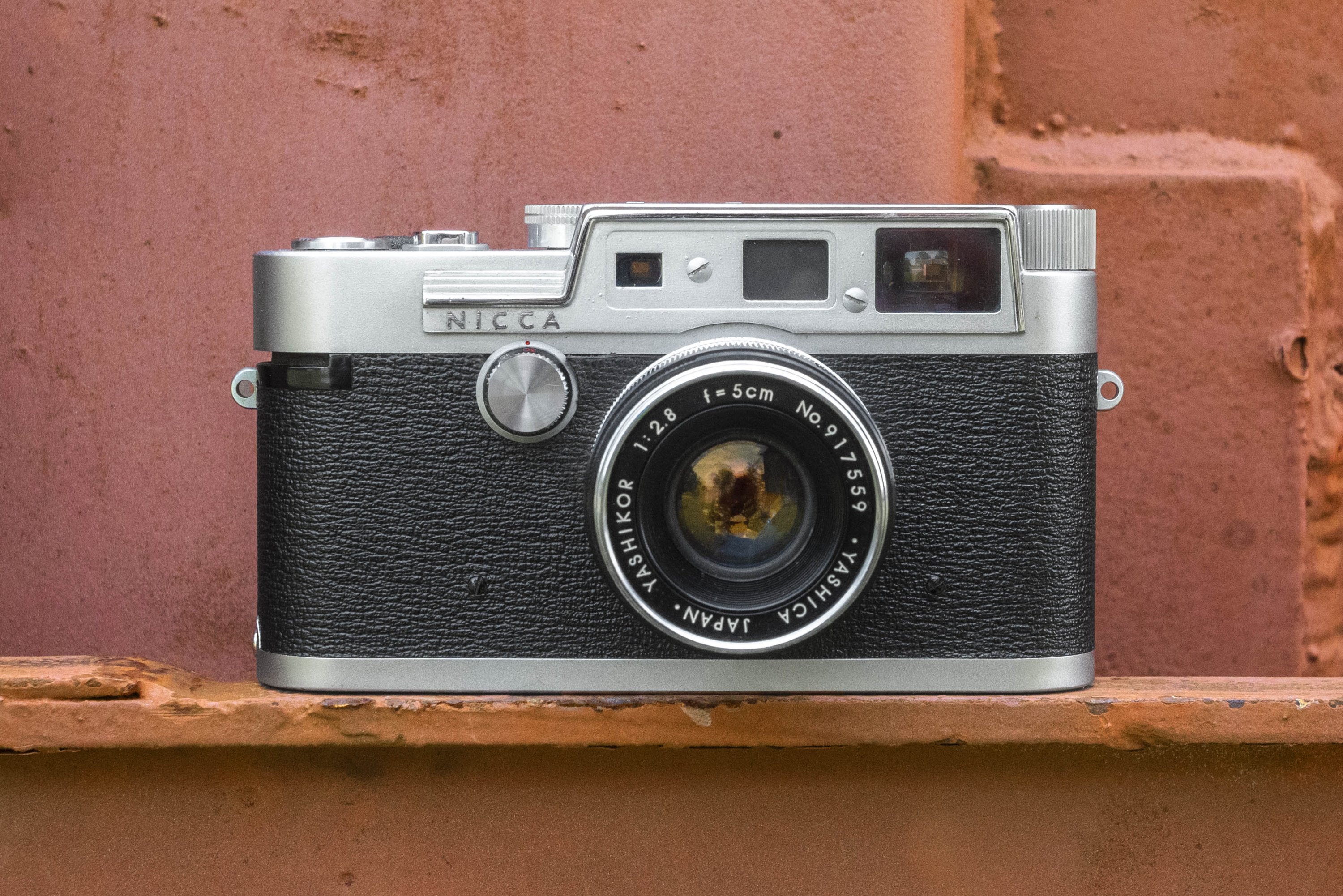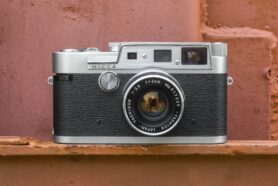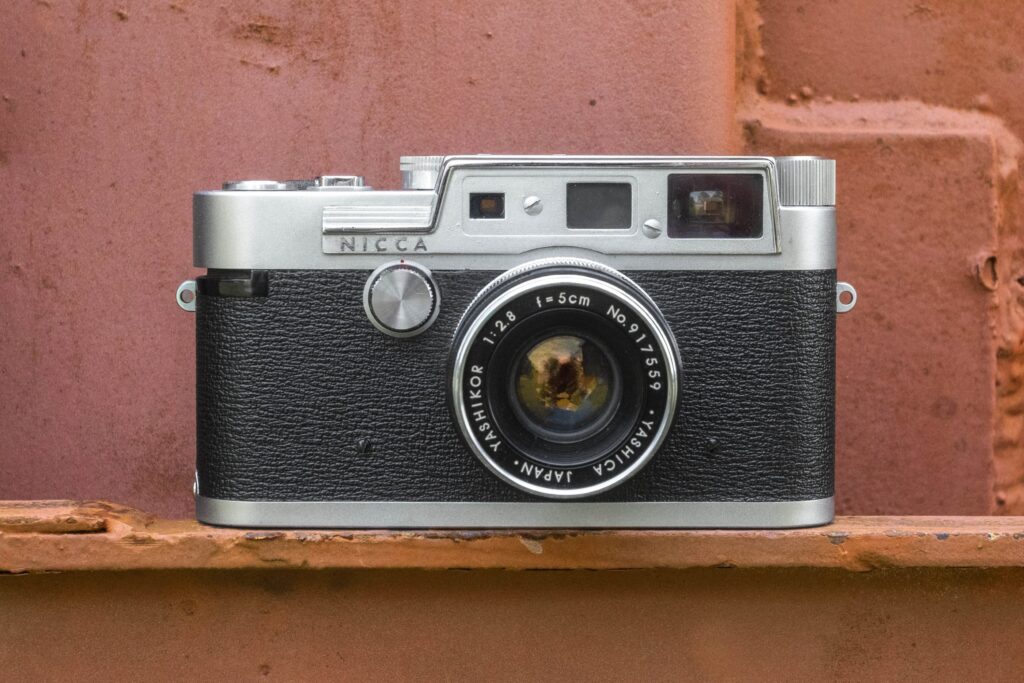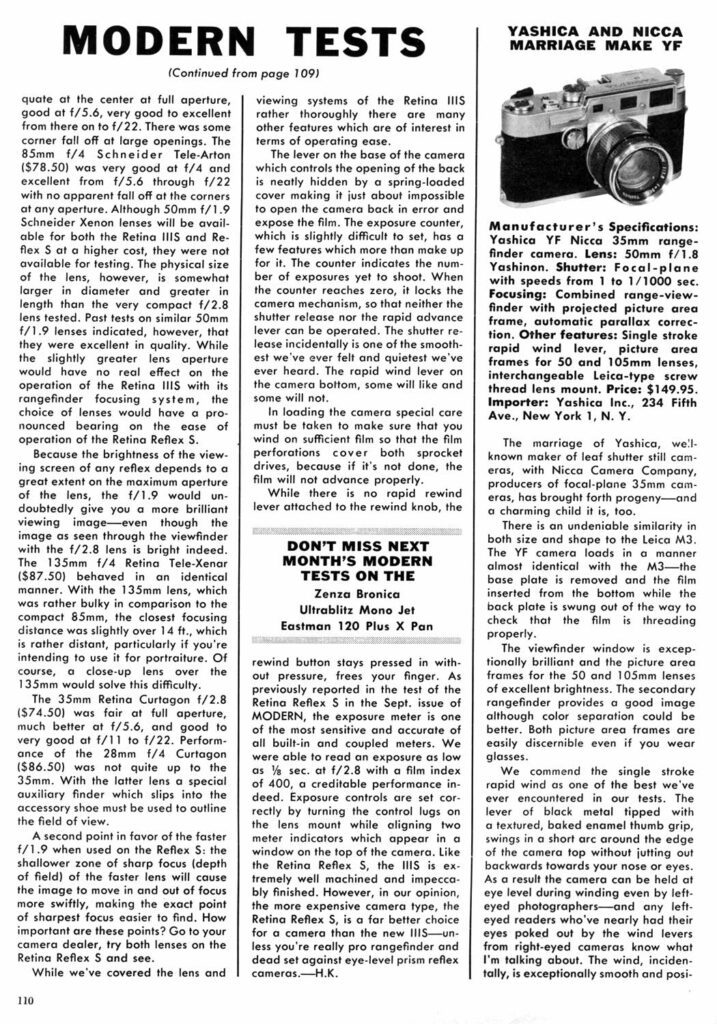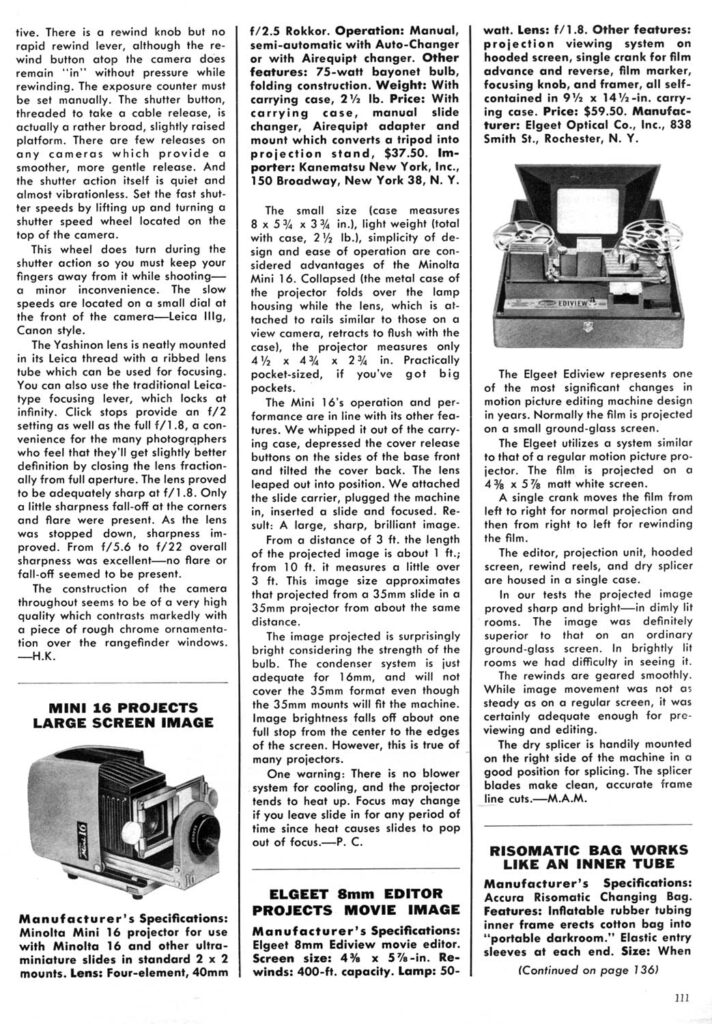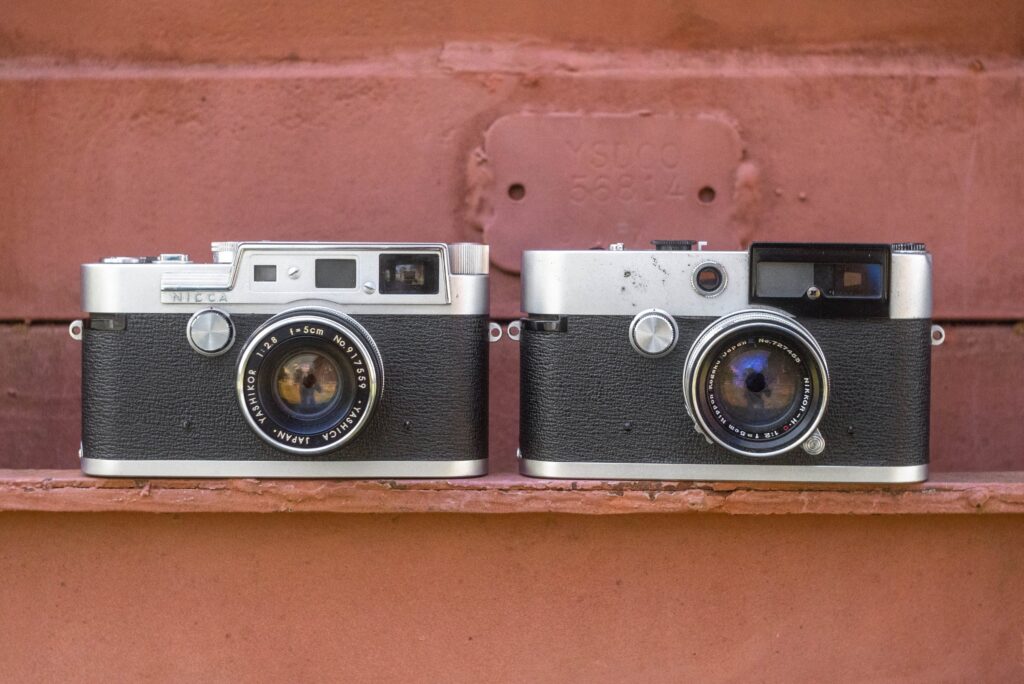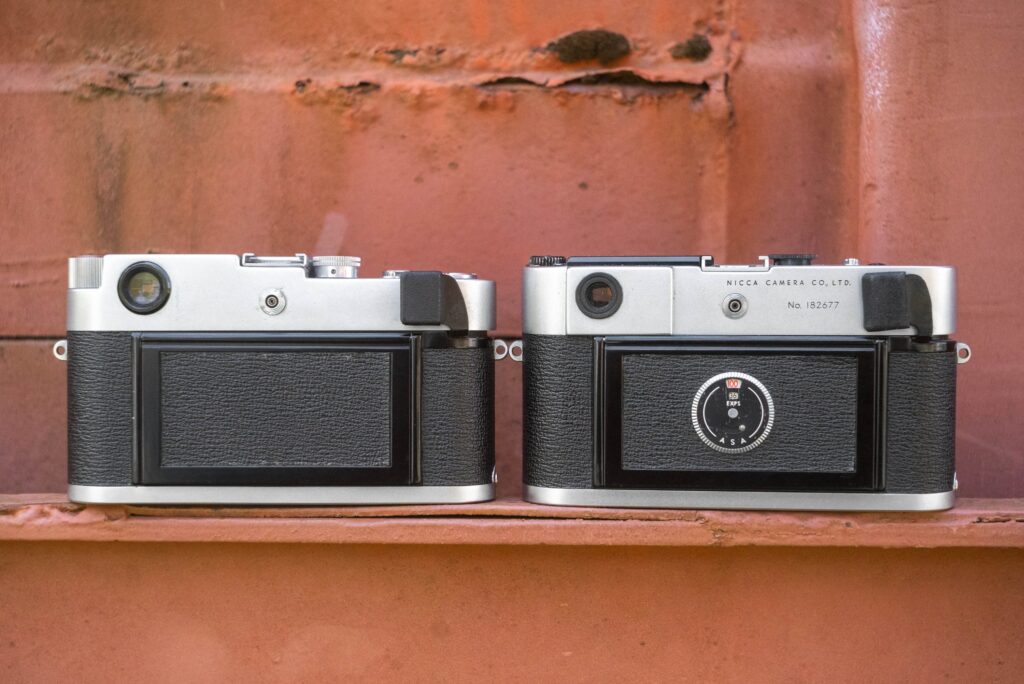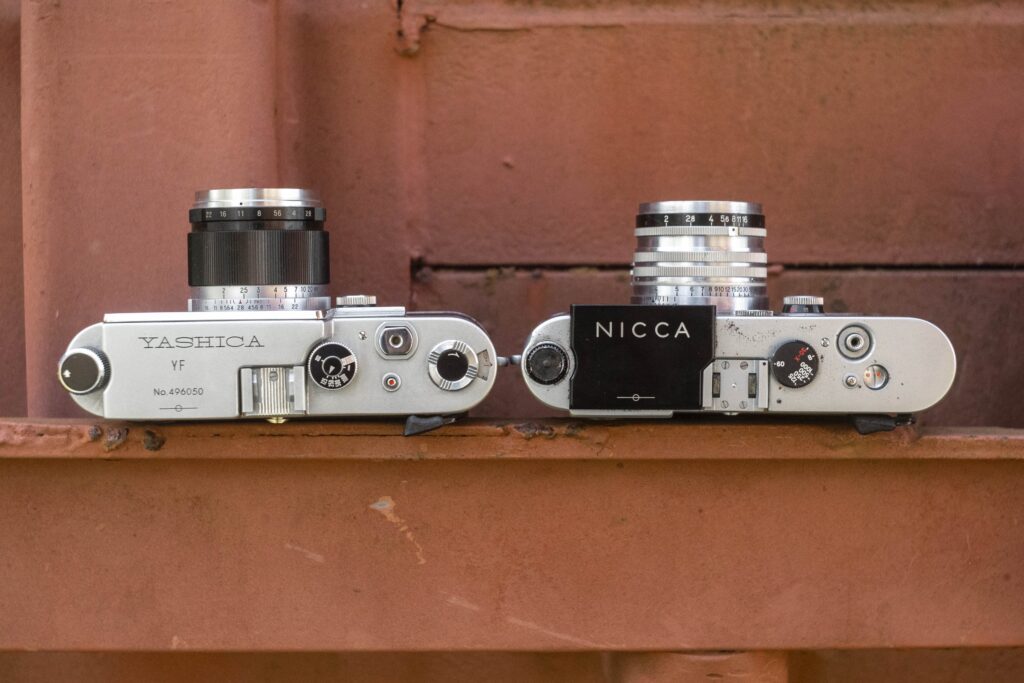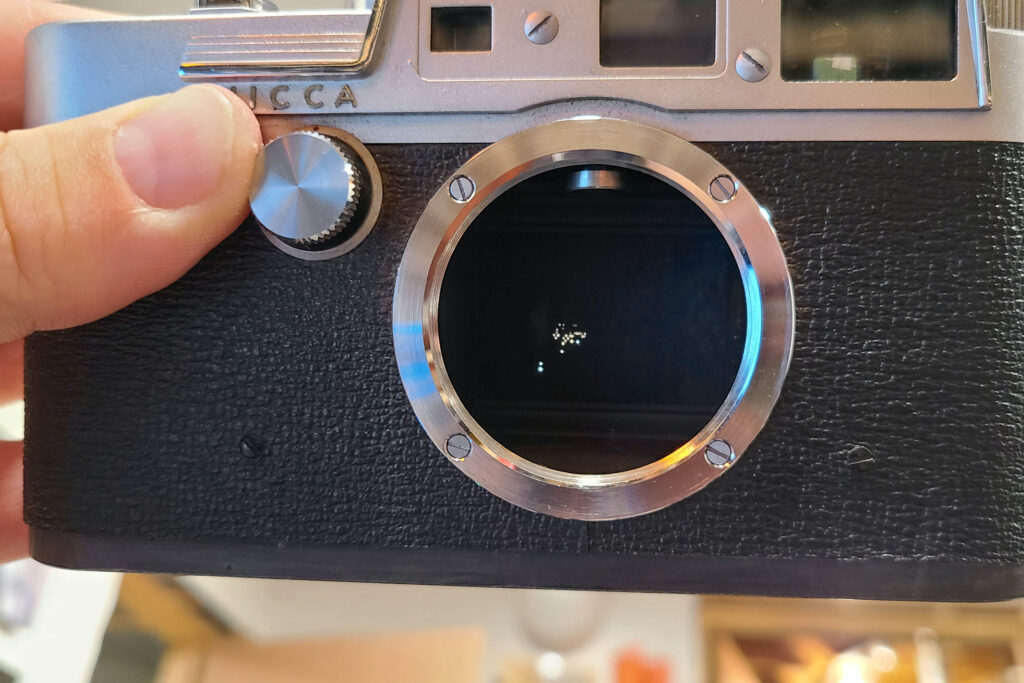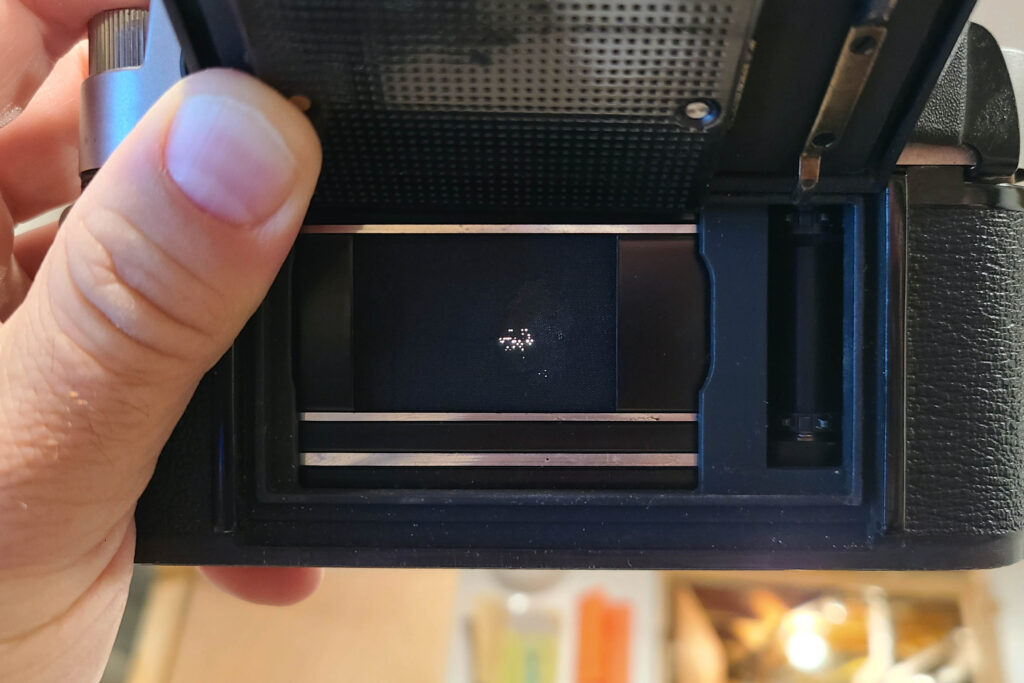This is the Yashica YF, a 35mm rangefinder camera made by Yashica Co., Ltd. in Japan starting in 1959. The Yashica YF was built very shortly after Yashica’s acquisition of Nicca the year before and although credited to Yashica, is a mostly cosmetic refresh of Nicca’s earlier type III rangefinders. It features a unique top plate and cosmetics, but otherwise features the same 39mm Leica thread lens mount, cloth focal plane shutter, and a combined image coupled rangefinder. Like many of Nicca’s other late 1950s rangefinders, the Yashica YF has several improvements over the original Leica III design, such as a rapid advance lever, Leica M3 style door in the rear of the camera, and parallax corrected frame lines. Although sold as an economically priced camera, the Yashica YF was very well built with a feature set that was competitive compared to much more expensive German designs.
Film Type: 135 (35mm)
Lens: 5cm f/2.8 Yashica Yashikor coated 5-elements in 4-groups
Lens Mount: 39mm Leica Thread Mount
Focus: 0.9 meters to Infinity
Viewfinder: Coincident Image Coupled Rangefinder w/ Automatic Parallax Correction
Shutter: Cloth Focal Plane
Speeds: B, 1 – 1/1000 seconds
Exposure Meter: None
Battery: None
Flash Mount: Cold shoe and M and X Flash Sync, 1/30 X-Sync
Other Features: None
Weight: 718 grams, 540 grams (body only)
Manual: http://leica-copies-japan.com/PDFs%20NonTLRs/Yashica%20YF%20(LoRes).pdf
How these ratings work | The Yashica YF was the final interchangeable lens rangefinder made by Nicca, released after that company’s acquisition by Yashica. Although a final model, it is built to a similar quality standard as previous Niccas and compares favorably to other quality Japanese cameras of the time. With the 5-element f/2.8 Yashinon lens, the camera is capable of excellent images, but by virtue of supporting interchangeable lenses, users of this camera have a ton of options. The camera is attractive with unique cosmetics and has excellent ergonomics, making shooting a joy. This is a good camera made by a good camera, but doesn’t do anything that other similar cameras can’t, making it a tough sell for someone with similar cameras, looking for something new. | ||||||
| Images | Handling | Features | Viewfinder | Feel & Beauty | History | Age | |
| 2 | 2 | 1 | 1 | 2 | 1 | 20% | |
| Bonus | None | ||||||
| Final Score | 10.8 | ||||||
History
During the final months of World War II, a new Japanese company named Yashima Seiki Seisakusho, or Yashima Precision Works in English was created that made a variety of goods for the Japanese war effort. This new company’s role during World War II was nearly insignificant as the war ended shortly after its creation, but with the help of American aide in the years after the war, would reform as a subcontractor of clock and other electronic parts.
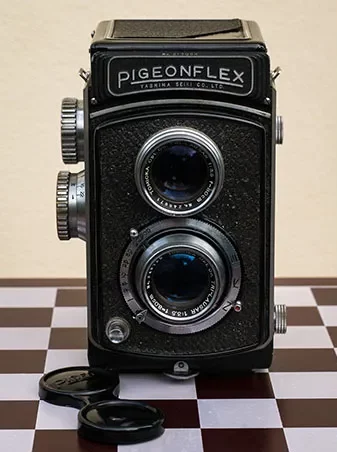
Yashima’s role in the rebirth of Japanese industrialization was small, but by the end of the 1940s would expand its product portfolio to include optical parts used by a variety of other companies. In 1953, Yashima would partner with a Japanese distributor named Endō Shashin Yōhin K.K., or Endō Photographic Supplies and would release its first camera, a 6cm x 6cm Twin Lens Reflex camera called the Pigeonflex.
The Pigeonflex was heavily inspired by Franke & Heidecke’s Rolleicord, which was a popular lower cost alternative to the same company’s Rolleiflex TLR. The Twin Lens Reflex design was hugely popular in Japan at the time and a dizzying array of Rolleiflex and Rolleicord copies were made by dozens of Japanese companies, including Yashima.
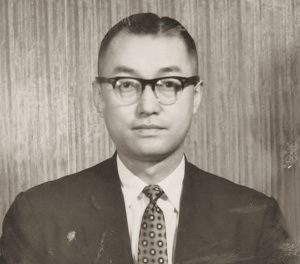
In the mid 1950s, of all the Japanese companies making TLRs, Yashima had a lot of success and developed a reputation as a quality optics company. Despite their success as a TLR maker, sometime in early 1957, Yashima’s president, Yoshimasa Ushiyama saw a dramatic shift in the photographic landscape with the increased popularity of 35mm cameras, namely Single Lens Reflex cameras. Although successful at making TLRs, Yashima had no experience with the smaller designs of 35mm cameras, or the focal plane shutters that they often came equipped with. Ushiyama was concerned that if Yashima didn’t act quickly, they would quickly be passed up by other Japanese companies like Asahi (Pentax), Chiyoda Kogaku (Minolta), and Miranda.
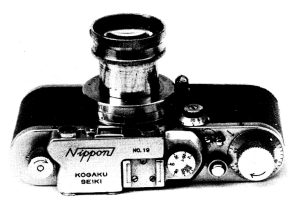
Around this time, another Japanese camera maker called the Nicca Camera Co. was having financial problems and on the verge of bankruptcy. Nicca had been making quality interchangeable lens 35mm rangefinders since the very early 1940s and had a positive reputation in Japan and abroad for their Nicca rangefinders.
During a large part of the 1950s, Nicca’s cameras sold reasonably well, especially in the United States through Nicca’s exclusive distribution deal with the Sears Roebuck & Company who sold rebadged Nicca cameras under their own Tower brand. By the end of the decade however, Nicca rangefinders were the only cameras that the company made and with waning interest in copies of the Leica III, Nicca found themselves unable to compete in the domestic and international camera industries.
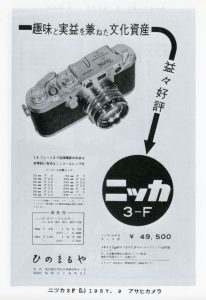
Like Nicca, Yashima found themselves to be making a single type of camera which was losing market share due to the rising interest in 35mm SLRs. Although neither company had experience making SLRs, Nicca did make 35mm cameras and had experience with focal plane shutters, something that Yashima identified as critical to the success of a new 35mm SLR.
Sensing an opportunity to acquire a company who already knew how to make a 35mm focal plane shutter, in early 1958, Yoshimasa Ushiyama put together a deal to bail out Nicca and combine the assets of the two companies together into a new company which would be called Yashica Co., Ltd. The new Yashica company would acquire the rights, designs, and technology of Nicca’s 35mm rangefinders and focal plane shutters, and what remained of Nicca’s lens operation would be a subsidiary company of Yashica called Taihō Kōgaku K.K.
Now with Nicca’s expertise and intellectual property, Ushiyama likely wasn’t interested in making copies of Leica rangefinders, but sensed a need to get into the 35mm market as quickly as possible. He knew that the development and construction of a new 35mm SLR would take some time, so in the short term, two Yashica branded cameras would quickly be rushed to the market based off existing Nicca designs.
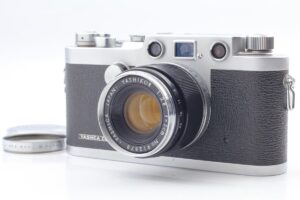
The two new cameras would be called the Yashica YE and Yashica YF and would be released in early 1959, less than 12 months after the Nicca merer. The Yashica YE was marketed for the Japanese market and was not intended for export although a few likely made it out of the country through various means. It would be a rebadged amalgam of two Nicca models, the Nicca Model 33 and Nicca 3-F. Featuring a body that was very similar to the 33, but with a shutter more similar to the 3-F and a switch to a f/2.8 Yashikor lens, the Yashica YE was the closest to a Leica III copy ever sold by Yashica.
The Yashica YF however would have a more substantial list of changes. For starters, the Yashica YF looked a lot different than the Yashica YE or any other Nicca ever made. Some comparisons have been drawn suggesting the Yashica YF is a rebadged Nicca III-L, but this isn’t true as each camera has some features that are missing from the other, and like the Yashica YE, was sold with Yashica’s own brand of lenses instead of Nippon Kogaku Nikkor lenses like most other Niccas. Two notable changes to the Yashica YF from the earlier Nicca III-L is the omission of the automatic resetting exposure counter, and that the Yashica has a two piece top plate shutter speed selector.
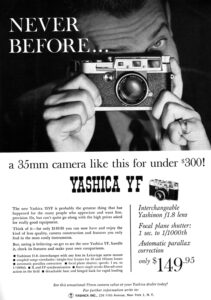
By far, the most obvious change to the Yashica YF was its cosmetics. Unlike every other Nicca rangefinder or the Yashica YE, the Yashica YF has a metal bezel around all three front windows. The YF is also the only camera to feature both the Yashica and Nicca names at the same time.
The reasoning for the dual Nicca and Yashica name has been hypothesized by many people, and while no official explanation from Yashica company records has ever been found, in his well researched article for both the Yashica YE and YF, Paul Sokk says that Yashica bought Nicca not only for their technology, but also their heritage and reputation, and it made sense to capitalize on that by displaying the Nicca name on the front of the camera. Although the Yashica YE came before the YF, only the YF was marketed in the United States where brand recognition was likely seen as more important.
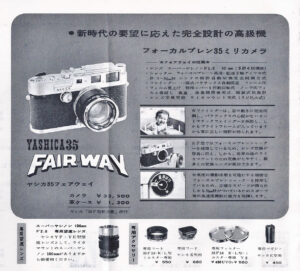
Interestingly, when sold in Japan, the Yashica YE and YF appeared in marketing and reference material as the Yashica 35 E-Type and Yashica 35 Fair-Way however the cameras were never engraved this way, Japanese and US market cameras look the same.
The exact date of release for the Yashica YF isn’t exactly known, but in an advertisement dated September 29, 1959 for a Singapore and Malaysia distributor, the camera was listed as “it’s here” perhaps suggesting a September release. If so, this matches the idea that production of the Yashica YF did not start until after the Yashica YE had completed.
The Yashica YF was produced into 1960 after the release of the Yashica Pentamatic SLR as both cameras have appeared in Yashica marketing material at the same time, but it is not known for exactly how long. Assuming the Yashica YF started showing up in stores inn September 1959, suggests the cameras started production a few months sooner, a short overlap of Yashica YF and Pentamatics until the summer of 1960 suggests the Yashica YF was only produced for about a year.
An ad from the Match 1960 issue of Modern Photography, along with a November 1959 Modern Test review of the Yashica YF below, both show a retail price of $149.95 with the f/1.8 lens. Although a few other lenses have been found with Yashica YFs such as the 5cm f/2.8 Yashikor, and an extremely rare 5cm f/2 Yashikor, both of these lense are thought to have been available in Japan only. The 5cm f/1.8 lenses Yashinon (later renamed Super-Yashinon) lenses are thought to have been the only kit lenses offered in the United States. When adjusted for inflation, a retail price of $149.95 is comparable to about $1600 today.
In the review above, Herbert Keppler draws similarities between the Yashica YF and Leica M3, which was likely intentional by the people who created it, although in retrospect, there’s no way that anyone in the market for a M3 would see the Yashica YF as a serious competitor. A more logical competitor would have been other Japanese screw mount rangefinders like those being offered by Canon, or those shopping for used Barnack Leicas.
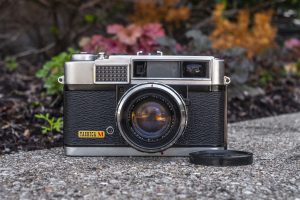
Positive comments about the viewfinder stated that is was exceptionally brilliant, the single stroke rapid film advance which could be used by left eye shooters without hitting their faces, and that the large and smooth shutter release was very quiet. The Yashinon lens was commended for its excellent sharpness and lack of flare when stopped down, only noting that the lens showed minimal signs of softness wide open. The build quality was noted to be of very high quality but that the frame around the rangefinder windows was made of rough chrome.
Although not stated as cons, the lack of a folding handle on the rewind knob, the manually resetting exposure counter, and that the shutter speed dial is still of the rotating type were noted, were clearly mentioned in contrast to the previously mentioned Leica M3.
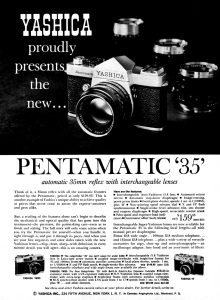
As was the case with most Modern Tests of the era, little else is said about the camera, functioning more as a preview of the camera rather than a full review, but it could be concluded that the general opinion of the camera was favorable.
In the years following the Yashica Pentamatic’s release, Yashica would never release another interchangeable lens 35mm rangefinder. The company would continue producing fixed lens rangefinder cameras with leaf shutters well into the 1970s as part of the Minister, Lynx, and Electro series. The Pentamatic’s focal plane shutter would be the last piece of influence from Nicca on future Yashica cameras.
Sadly, the Pentamatic would not win over a large number of buyers and would quickly be replaced the Yashica J-Series of SLRs, and eventual TL-Series, all with M42 “universal” screw mounts. Yashica would enjoy success a the low to mid level of the market, making a large number of good, but not great cameras. It wouldn’t be until the company’s acquisition of the Contax trademark in the mid 1970s when new upper end Yashica/Contax SLRs would bring a bit of prestige back into the brand.
Today, Yashica cameras are generally favorable, but their two short lived interchangeable lens rangefinders are mostly forgotten. That the Yashica YE is difficult to distinguish from Nicca’s confusing line of similar models and the YF’s short production run, these camera’s aren’t super common, nor well known outside of the dedicated collector’s community. Between the two, the YF has the most striking appearance and as such is the model most collectors seek out. Examples of good Yashica YF’s with the f/1.8 lens can fetch prices between $300-$500 depending on condition, making them one of the more expensive Leica Thream Mount cameras out there. If you find a good working example for less than that, I’d encourage you to strongly consider picking it up!
My Thoughts
Having shot a great number of Leica Thread Mount 35mm rangefinders, two distinct groups begin to emerge. The first are those who mostly stay true to the original Leica III formula that these cameras are based on, and those who stray quite a bit in design in features. Along with cameras like the Canon 7 and Tanack Type-V3, the Yashica YF has a great deal of changes from the original formula.

As one of the better looking cameras of its era, along with the excellent build quality of Nicca, the Yashica YF is an interesting camera to use but apparently I am not the only person who is interested in it as prices for them can be quite high. It took me a while to find a good version to test, but when one finally showed up on my doorstep from Japan, I was eager to remove all of the packaging tape and bubble wrap.
As I had suspected, the build quality of the Yashica YF is very good, and easily on par with previous Nicca rangefinders I’ve tested. Although the Yashica YF is its own unique model and not simply a rebadge of an existing Nicca camera, it shares quite a bit of similarities to the Nicca III-L, which itself was the very last camera released by Nicca before its merger with Yashica.
The two cameras share the same basic body, shutter, lens mount, and many other features, but they are not exactly the same. The Yashica has a few things like multiple frame lines and a different magnifying ratio than the Nicca, but the Nicca has features like an auto resetting exposure counter and film reminder dial on the rear door which the Yashica lacks. Throughout this section, I will detail the differences between the two models where I noticed changes.
I like the cosmetics of the Yashica YF, especially the bezel on the front of the camera, which gives it a sort of “1950s American Automobile” look to it, but I’ve noticed the material and/or finish of the bezel is different from the same body. Whether or not it is made from a different material or was finished differently, it definitely has a “tacked on” appearance. Looking at other Yashica YFs online, I have seen some where the bezel shows more corrosion than the body, so that is something anyone looking to pick one of these up, should be mindful of.
The rest of the camera is comparable to the best Japanese cameras of the era, fit and finish is excellent, the synthetic body covering has a nice texture on it and shows no signs of cracking or peeling, and each of the camera and lens controls move with just the right amount of resistance without being too tight or too loose.
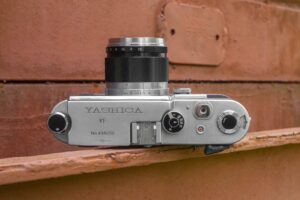
Up top, the Yashica YF is a blend of old and new, with most controls in their familiar locations. On the left is a small rewind knob which can be lifted into a raised position to make rewinding easier, but if you prefer keeping it down, it still works that way too. On the raised portion of the top plate is the camera’s name, serial number, a focal plane indicator, and the accessory shoe.
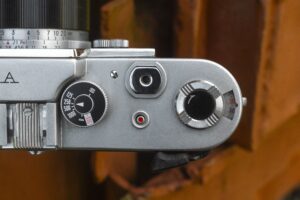
On the lowered portion to the right, is the shutter speed selector. Unlike the single piece shutter speed selector from the earlier Nicca III-L, the one here reverts to a two piece design in which the outer portion needs to be lifted up and aligned with an error to select a shutter speed. Changes can be made with or without the shutter being set. Only fast speeds from 30 to 1000 plus Bulb are available on the top dial as the slow speeds are chosen using a separate dial on the front of the camera. The entire shutter speed dial rotates both when cocking and firing the shutter, so you must take care not to touch the dial while firing the shutter as it will throw off the speed. The setting for 30 is also the X-sync setting as well. The face of the shutter speed dial is painted black with silver lettering and matches the black face on top of the rewind knob and exposure counter.
To the right of the shutter speed selector is the large chrome shutter release which is like an oval but with flat sides. The shutter release is much bigger than that of other Nicca cameras and is threaded for a cable release. Beneath it is a small chrome button with a red dot in the center which deactivates the film transport for rewinding the film. Constant pressure does not need to be maintained on this button while rewinding film as it will stay down once pressed. Advancing the film will cause it to pop back up into the normal position. Finally, on the far right is the additive exposure counter and reset wheel. Unlike the earlier Nicca III-L, the Yashica YF does not have an automatic resetting exposure counter, so you must reset it back to 0 after loading in a new roll of film.
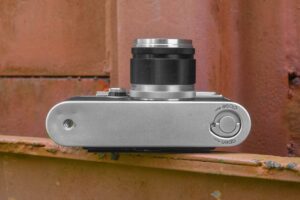
The base of the camera is pretty uneventful with only the Open/Close lock for opening the film compartment and a 1/4″ tripod socket. Like most screw mount Leica and Leica copies, the tripod socket is on one edge of the camera which means the camera is not balanced while mounted to a tripod. This example is like many others and shows dents around the edges of the socket for this reason. It doesn’t impact the function of the camera, but in extreme cases, could damage the base plate enough to where it might start to cause light leaks in the film compartment.
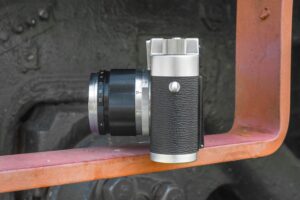
Like most bottom loaders, there’s not much to see on the sides other than metal strap lugs. The ones on this camera are made out of the same metal as the body and on this example were still in good condition, suggesting they’ve seen little use throughout their life. The right side of the camera has that little circular post for attaching the base plate, like most screw mount rangefinders.
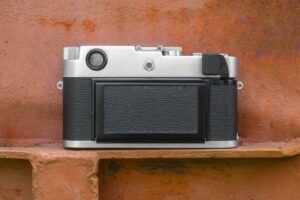
Around back, the Yashica YF has a large circular eyepiece for the viewfinder. The viewfinder appears to be identical to the one used on the Nicca III-L, and although they’re larger than earlier Leicas and Leica copies, it is smaller than that of the Canon P and 7. To the right of the eyepiece, immediately behind the accessory shoe is a coaxial flash sync port, and to its right is the film advance lever. The lever is comfortably located within easy reach of your right thumb and has a black plastic thumb rest on the tip, improving comfort while winding the camera. By far, the most significant thing on the back of the camera is the Leica M-style rear film door. The door on the Yashica looks identical to the Nicca III-L, except it does not have a film reminder dial in the center.
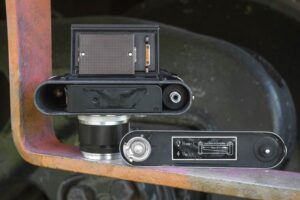
Opening the film compartment is a two step process. First, you must turn the key on the base to the Open position and then lift off the base plate. Then using a ridge on the bottom of the film door, raise the top hinged door to reveal the film compartment. Like other cameras with a door like this, film still must be loaded through the bottom of the camera and not through the door. Having the door there helps guarantee that the film is seated, eliminating the need on most bottom loaders to trim the leader to 10cm. A plate on the inside of the base plate still recommend a 10cm leader, but I have found it is not absolutely necessary. A strange feature of this door is that it is removable. There is a chrome lever near the top left hinge that when slid to the right allows you to remove it. I cannot think of a good reason to do this other than maybe if some kind of accessory back was planned but never released. This feature is also present on the Nicca III-L and is something I missed when I reviewed that camera back in June 2022.
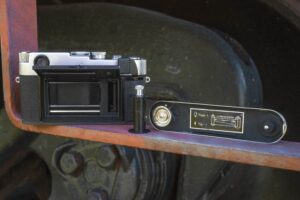
Film transports from left to right onto a removable take up spool. Leica style reloadable metal cassettes can be used on the Yashica YF as the bottom door key has the guides to open and close the cassette upon unlocking and locking the film compartment. The Yashica YF comes with a modern extendable take up spool, in which a post on the end can be pulled out, making getting a hold of the spool with your fingers much easier. Canon was the first company to do this in the early 1950s and since then, this design was copied by most companies who make bottom loaders.
With the rear door open, we get a look at the pressure plate which is a large piece of black painted metal covered in divots to reduce friction as film passes over it. Dual film rails are above and below the film gate, and have a polished finish to further reduce friction. A strip of black felt is in the bottom channel of the hinged door to keep light leaks out, but is not around the entire perimeter of the door or the bottom plate. The black felt appeared to be in good condition on this example, and did not require replacement. When closing the camera, be sure to close the rear door first, as the bottom plate will interfere with it.
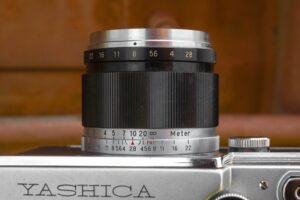
Looking down upon the top of the lens, the Yashikor 5cm f/2.8 lens looks like most other rangefinder lenses including the Super-Yashinon 5cm f/1.8 lens which is much more commonly found on Yashica YFs. Closest to the body is an engraved depth of field scale with a red IR index mark between f/5.6 and f/8. A large metal focus wheel takes up most of the thickness of the lens with distances marked from just under 1 meter to infinity. Near the front of the lens is the aperture ring with click stops from f/2.8 to f/22.
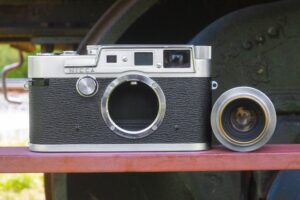
Up front, besides the cosmetic bezel around the windows, the Yashica YF looks like most other modern screw mount rangefinder cameras. A separate slow shutter speed dial is near the 10 o’clock position of the lens mount and has an attractive white on black shutter speed scale that looks almost identical to the one from the Nicca III-L. The only difference is that the Yashica YF does not have a T setting like the Nicca did. The lens mount is a standard 39mm Leica Thread Mount and uses a round wheel on the tip of the rangefinder feeler just like every other Japanese Leica copy. Beyond the slow shutter speed dial and lens mount, there is nothing else to see on the front of the camera, not even a self-timer.

The viewfinder is large and bright with a green tinted main viewfinder with white frame lines and a rectangular rangefinder patch. Two sets of frame lines, one for 50mm and another for an optional 100cm lens made for the YF are visible. Both sets of frame lines automatically correct for parallax. The Yashica YF viewfinder has a higher magnification ratio than the Nicca III-F which means things in the viewfinder appear smaller, but the benefit is that you can easily see all four edges of the 50mm frame lines while wearing prescription glasses, something I cannot do on the Nicca. The Nicca III-L does not have the 100cm frame lines, although that wouldn’t stop you from using a 100cm lens on it. Beyond the frame lines and rangefinder patch, there is nothing else to see within the viewfinder.
Although the Yashica YF was Yashica’s US introduction to interchangeable lens 35mm rangefinder cameras, it would also be their last as the company would shift their focus to simpler fixed lens rangefinders and SLRs in the 1960s. The Yashica YF is an interesting camera as both the first and last of something, made with two different company names on it, plus an amalgam of new and modern features, on a body whose basic design dates back to the 1930s.
Whatever part of the Yashica YF’s history is interesting to you, it is clear that this is a well made camera, that both is deserving of Nicca’s past and Yashica’s future. But what is it like to shoot? Keep reading…
Repairs
This Yashica YF and lens came to me from a Japanese seller. I had been on the lookout for one for quite a while, but the prices were unreasonably high, and a majority of bodies came without lenses, so when I saw this camera and lens with a Buy it Now considerably less than what the others were going for, I was ready to buy, except there was only one problem, which was that the seller listed the shutter was inoperable with light leaks. There were no images of the shutter in the auction, but the price was good, and the camera looked nice, so I bought it anyway.
Upon arrival, as expected, the shutter was in bad shape with a large patch of “Swiss Cheese” holes. Looking at the area where the holes were, it looks like someone previously tried to repair it with some black paint, but it clearly didn’t work.
Still wanting to shoot this camera, I packaged it up and sent it off to Allen Wade at Cameraworks in New York and asked him to replace the curtains and give the camera a complete CLA.
Allen has done work for me before so I trusted him to take care of everything, and about 14 days later, I received the camera back, good as new with new curtains, accurate shutter timings, cleaned viewfinder, and calibrated rangefinder. Woohoo!
My Results
Shortly after getting the camera back from Allen Wade knowing that it was in perfect operational condition, I was eager to load in some film and take it out shooting. It is not every day you get to shoot a “good as new” 65 year old camera, but that day came, and I was ready with some fresh Fuji 200. Although I probably could have taken the camera anywhere and felt confident that it would not fail me, I still played it safe and kept it with me as a general all purpose camera, taking photos of every day things I was doing. Maybe one day I’ll push it more to its limits and shoot a wedding or something…
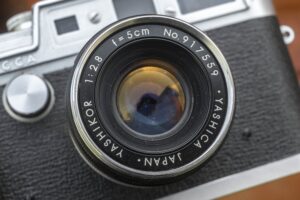
If you came here to find out if the Yashica YF made good images, yeah it did. It made good images, just like pretty much every Yashica camera or interchangeable lens rangefinder I’ve ever shot. Yashica’s lenses, even the lower end ones like this 5-element f/2.8 Yashikor are going to make images with excellent sharpness, contrast, color rendition, and without many of the typical flaws you’d often find in lesser lenses. So yeah, it did a good job.
The question you should be wondering the answer to, was if the Yashica YF was a fun camera to shoot, and whether or not I’d recommend someone get one of their own.
The Yashica YF is much like other late 1950s/early 1960s interchangeable lens rangefinders made by Canon, Nicca, Tanack, and others. All started with the same basic formula developed by Ernst Leitz of Wetzlar, Germany in the 1920s and 1930s, making mostly faithful copies of the Leica II and III, but eventually evolving and upgrading the original design with bigger and better viewfinders, film advance levers, hinged backs, and other features. The Yashica YF benefits from nearly every innovation added to the original Leica Thread Mount formula, except for a selenium meter and a hinged back. It is almost as modern of a Leica copy as you can get, without completely rebooting the design.
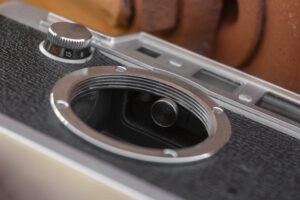
What I like the most about the Yashica YF is that each of its improvements is well thought out and does something to make the shooting experience better, but without changing so much of the original formula, that it feels like a completely different camera. If you had a collection of prewar Leitz Elmar lenses or early post war Nikkor lenses, they will work on this camera. With the huge number of Leica Thread Mount lenses made by German, Japanese, and Soviet companies, the possibilities for lenses are endless. In addition, if you are an owner of a 2000s era Cosina built Voigtlander Bessa rangefinder, you can swap lenses with this camera as well.
Each of the upgrades to the Yashica YF make it a better camera, and for that, yes, I absolutely recommend it. The film advance lever is in an ergonomically ideal location on the back plate of the camera, with just the right amount of travel that you can quickly advance the film without having to move the camera far from your eye. The more forward location and huge size of the shutter release is very comfortable and easy to reach with your right index finger. The viewfinder is large enough and the frame lines which automatically correct for parallax ensure that your images should all be properly framed. The hinged rear door makes loading film through the bottom of the camera very easy and gives you the ability to inspect the curtain, which is very useful to know the condition of the shutter when picking one of these up.
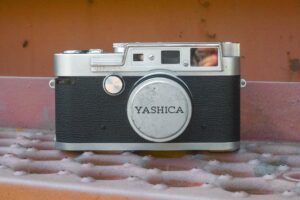
Where the Yashica YF falls a bit short is that it doesn’t do anything that a Canon P or other late 1950s Japanese LTM rangefinder does. In fact, when comparing it to the very similar Nicca III-L, it loses the automatic resetting exposure counter, T shutter speed, and film reminder dial on the back of the camera. Even if it had those features, if you already had another late 1950s Japanese LTM rangefinder, and supplemented your collection with a Yashica YF, you’re not likely to find anything to like about it that you don’t already like from your current collection. Quite simply, its just a pretty face on a formula that has been used many times before.
If however, you do not already have a wide selection of similar cameras, the Yashica YF is an excellent representation of the era. Despite being one of the last of its kind made by either Nicca or Yashica, build quality is still very good. The ergonomics of the body, lens, film advance, and shutter release are excellent and whether you have the 5-element Yashikor or 6-element Super Yashinon, you are going to get excellent images.
I am happy to have the Yashica YF in my collection and will certainly use it again, but not because it does anything that I can’t already do on a number of other cameras that sit next to it on the shelf.
External Links
http://camera-wiki.org/wiki/Yashica_YF
http://leica-copies-japan.com/YE&YF.html
http://www.alexluyckx.com/blog/2018/04/16/ccr-review-86-yashica-yf/

